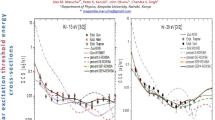Abstract
We study the scattering of electrons and positrons by argon and krypton atoms considering a generalized uncertainty principle (GUP). To proceed, we first prove the modified non-relativistic wave equation due to the minimal length in the GUP framework and then determine the wave function of incident particles applying a scattering potential including the static and the energy-dependent correlation–polarization contributions. Finally, we compute the transmission and reflection probabilities from potential barrier. It will be shown that some exotic phenomena occur in this framework which cannot be justified by the ordinary quantum mechanics.







Similar content being viewed by others
References
J R Danielson and D H E Dubin Reviews of Modern Physics 87 247 (2015).
B Franke Eur. Phys. J. D 71 1 (2017).
J Vahedi, K Nozari and P Pedram Gravit Cosmol 18 211 (2012).
J Vahedi and K Nozari Acta Physica Polonica A 122 38 (2012).
P Pedram Physical Review D 85 024016 (2012).
M Asghari, P Pedram and K Nozari Physics Letters B 725 451 (2013).
A Kempf, G Mangano and R B Mann Physical Review D 52 1108 (1995).
S Das and E C Vagenas Canadian Journal of Physics 87 233 (2009).
S Das and E C Vagenas Physical Review Letters 101 221301 (2008).
K Jahankohan, H Hassanabadi and S Zarrinkamar Modern Physics Letters A 30 1550173 (2015).
A Armat and S Mohammad Moosavi Nejad Modern Physics Letters A 33 1852231 (2018).
K E Thylwe and H J Korsch J Phy A: Math Gen 34 3497 (2001).
H J Korsch, H Laurent and R Mohlenkamp J Phys B: At Mol Opt 14 4213 (1981).
D D Reid and J M Wadehra J Phys B: At, Mol Opt Phys 47 225211 (2014).
D D Reid and J M Wadehra Physical Review A 50 4859 (1994).
S H Dong and M Lozada-Cassou Physica Scripta 74 285 (2006).
S Dong, S H Dong, H Bahlouli and V B Bezerra International Journal of Modern Physics E 20 55 (2011).
A S De Castro, A Armat and H Hassanabadi Eur. Phys. J. Plus 129 10 1–7 (2014).
P Pedram Europhysics Letters 89 50008 (2010).
P Wang, H Yang and X Zhang JHEP 8 43 (2010).
F Scardigli Physics Letters B 452 39 (1999).
S Mohammad Moosavi Nejad and Mahdi Delpasand Int. J. Mod. Phys. A 30 1550179 (2015).
S Mohammad Moosavi Nejad Eur. Phys. J. A 52 127 (2016).
S Mohammad Moosavi Nejad and Mahboobe Balali Eur. Phys. J. C 76 173 (2016).
S Mohammad Moosavi Nejad and Mahboobe Balali Phys. Rev. D 90 114017 (2014).
Author information
Authors and Affiliations
Corresponding author
Additional information
Publisher's Note
Springer Nature remains neutral with regard to jurisdictional claims in published maps and institutional affiliations.
Appendix
Appendix
In this appendix, the wave function \(\phi (x)\) satisfying the boundary conditions (4) and (5) is constructed from the particular amplitude-phase solutions discussed in Sect. 2. For the left side of the barrier, the solution \(\phi_{L}^{ - } (x)\) can be written as
where \(\delta_{{\text{L}}} = - \lim_{x \to - \infty } (U_{{\text{L}}} - S_{{\text{L}}} x)\) and \(\Omega_{{\text{L}}} ( - \infty ) = 1/\sqrt {S_{{\text{L}}} }\).
Using the matrix (8), one also has
where \(\delta_{R} = \lim_{x \to \infty } (U_{R} - S_{R} x)\) and \(\Omega_{R} (\infty ) = 1/\sqrt {S_{R} }\).
According to the matrix (8) and the relations (26) and (27), one obtains
Normalizing (28) according to Eq. (5), for the transmission and reflection amplitudes, one finds the following formulae
where the phases \(\delta_{{\text{R}}}\) and \(\delta_{{\text{L}}}\) are real. According to the definition of the T-coefficient and R-coefficient, one has
Rights and permissions
About this article
Cite this article
Moosavi Nejad, S., Armat, A. Scattering of electrons and positrons from argon and krypton in the GUP framework. Indian J Phys 96, 1433–1441 (2022). https://doi.org/10.1007/s12648-021-02062-9
Received:
Accepted:
Published:
Issue Date:
DOI: https://doi.org/10.1007/s12648-021-02062-9



